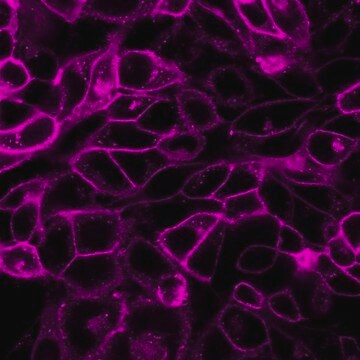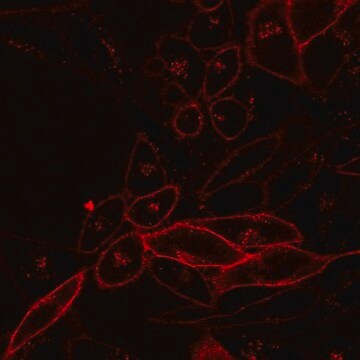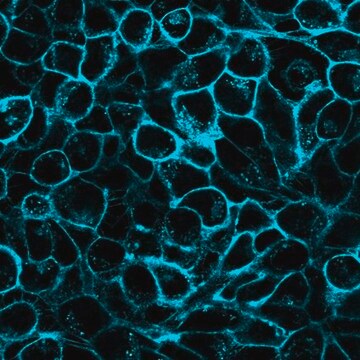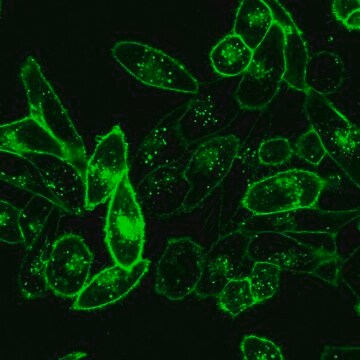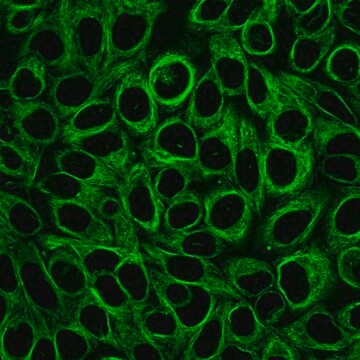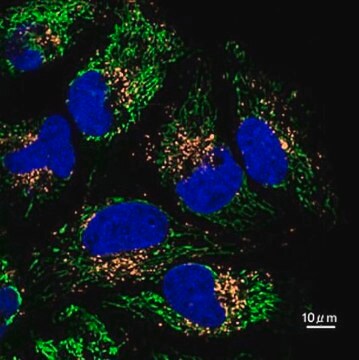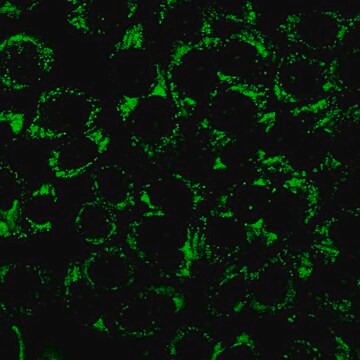SCT113
BioTracker NIR750 Cytoplasmic Membrane Dye
Live cell imaging lipophilic carbocyanine membrane dye suitable for long-term fluorescent cell labeling and cell tracking studies.
Synonym(e):
Live cell imaging probe
Anmeldenzur Ansicht organisationsspezifischer und vertraglich vereinbarter Preise
Alle Fotos(1)
About This Item
UNSPSC-Code:
12352207
NACRES:
NA.47
Empfohlene Produkte
Methode(n)
cell based assay: suitable
Nachweisverfahren
fluorometric
Versandbedingung
ambient
Allgemeine Beschreibung
Lipophilic carbocyanine dyes are widely used for labeling neurons in tissues by retrograde labeling, and to label membranes in a wide variety of cell types. The dyes are weakly fluorescent in aqueous phase, but become highly fluorescent in lipid bilayers. Staining is highly stable with low toxicity and very little dye transfer in between cells, making the dyes suitable for long-term cell labeling and tracking studies. When live cells are stained, the dyes label plasma membranes and also are taken up into endocytic compartments. Cells can be fixed either before or after staining, although permeabilization affects the staining pattern.
Unlike PKH dyes, BioTracker Cytoplasmic Membrane Dyes do not require a complicated hypoosmotic labeling protocol. They are ready-to-use dye delivery solutions that can be added directly to normal culture media to label suspended or adherent cells in culture.
NIR Cytoplasmic Membrane Dyes are novel near-infrared carbocyanine dyes for labeling the cytoplasmic membranes of living cells. Due to their long emission wavelengths, near-infrared cell membrane stains can be used to label cells for near-infrared small animal imaging studies for non-invasive imaging of cell migration and cell homing.
Spectral Properties
Absorbance: 748nm
Emission: 780nm
Unlike PKH dyes, BioTracker Cytoplasmic Membrane Dyes do not require a complicated hypoosmotic labeling protocol. They are ready-to-use dye delivery solutions that can be added directly to normal culture media to label suspended or adherent cells in culture.
NIR Cytoplasmic Membrane Dyes are novel near-infrared carbocyanine dyes for labeling the cytoplasmic membranes of living cells. Due to their long emission wavelengths, near-infrared cell membrane stains can be used to label cells for near-infrared small animal imaging studies for non-invasive imaging of cell migration and cell homing.
Spectral Properties
Absorbance: 748nm
Emission: 780nm
Anwendung
Live cell fluorescent imaging
Live cell imaging lipophilic carbocyanine membrane dye suitable for long-term fluorescent cell labeling and cell tracking studies.
Research Category
Cell Imaging
Cell Imaging
Research Sub Category
Live Cell Dye
Live Cell Dye
Qualität
Spectral Properties
Absorbance: 748nm
Emission: 780nm
Absorbance: 748nm
Emission: 780nm
Physikalische Form
Liquid
Lagerung und Haltbarkeit
Store BioTracker NIR750 Cytoplasmic Membrane Dye at room temp. Protect From Light.
Note: Centrifuge vial briefly to collect contents at bottom of vial before opening.
Note: Centrifuge vial briefly to collect contents at bottom of vial before opening.
Haftungsausschluss
Unless otherwise stated in our catalog or other company documentation accompanying the product(s), our products are intended for research use only and are not to be used for any other purpose, which includes but is not limited to, unauthorized commercial uses, in vitro diagnostic uses, ex vivo or in vivo therapeutic uses or any type of consumption or application to humans or animals.
Lagerklassenschlüssel
10 - Combustible liquids
WGK
WGK 1
Flammpunkt (°F)
188.6 °F - (refers to pure substance)
Flammpunkt (°C)
87 °C - (refers to pure substance)
Analysenzertifikate (COA)
Suchen Sie nach Analysenzertifikate (COA), indem Sie die Lot-/Chargennummer des Produkts eingeben. Lot- und Chargennummern sind auf dem Produktetikett hinter den Wörtern ‘Lot’ oder ‘Batch’ (Lot oder Charge) zu finden.
Besitzen Sie dieses Produkt bereits?
In der Dokumentenbibliothek finden Sie die Dokumentation zu den Produkten, die Sie kürzlich erworben haben.
Kunden haben sich ebenfalls angesehen
Unser Team von Wissenschaftlern verfügt über Erfahrung in allen Forschungsbereichen einschließlich Life Science, Materialwissenschaften, chemischer Synthese, Chromatographie, Analytik und vielen mehr..
Setzen Sie sich mit dem technischen Dienst in Verbindung.